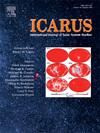Secondary craters reveal differences in neighboring geologic units: An example on Mars
IF 2.5
2区 物理与天体物理
Q2 ASTRONOMY & ASTROPHYSICS
引用次数: 0
Abstract
Secondary craters, formed from ejecta during impact events, complicate surface age estimation, as they violate key assumptions required for age inference from crater counts. However, the nearly common formation conditions of nearly co-located secondaries make them potentially useful for inferring target properties. We present a technique to estimate surface property differences between bordering geologic units using secondary crater characteristics. This process is straightforward if secondary crater clusters sourced from a known primary crater cross a geologic border and can be properly surveyed. We demonstrate the technique at the geologic contact between Amazonis Planitia, a volcanic plain, and the Olympus Mons aureole, a landslide deposit, on Mars. We located a secondary crater cluster sourced from the primary crater, Tooting, which impacted ∼165 km to the southwest in Amazonis Planitia. The Tooting-sourced secondary craters in Amazonis Planitia are ∼1.43 times larger than the craters found just across the geologic border in the Olympus Mons aureole. The smaller craters in the aureole suggest the aureole is either stronger and/or more porous. Based on the geology of those units, we prefer an explanation that attributes the difference to increased porosity; if so, the mean porosity in the aureole is >43 %. The technique we employ here can be applied to any solid surface in the solar system with young impact craters relative to the target surfaces and clear geologic contacts where the contact transition is shorter than the width of the secondary crater cluster. We encourage others to use this technique opportunistically when contact-crossing secondary clusters are discovered in their geologic analysis.
求助全文
约1分钟内获得全文
求助全文
来源期刊

Icarus
地学天文-天文与天体物理
CiteScore
6.30
自引率
18.80%
发文量
356
审稿时长
2-4 weeks
期刊介绍:
Icarus is devoted to the publication of original contributions in the field of Solar System studies. Manuscripts reporting the results of new research - observational, experimental, or theoretical - concerning the astronomy, geology, meteorology, physics, chemistry, biology, and other scientific aspects of our Solar System or extrasolar systems are welcome. The journal generally does not publish papers devoted exclusively to the Sun, the Earth, celestial mechanics, meteoritics, or astrophysics. Icarus does not publish papers that provide "improved" versions of Bode''s law, or other numerical relations, without a sound physical basis. Icarus does not publish meeting announcements or general notices. Reviews, historical papers, and manuscripts describing spacecraft instrumentation may be considered, but only with prior approval of the editor. An entire issue of the journal is occasionally devoted to a single subject, usually arising from a conference on the same topic. The language of publication is English. American or British usage is accepted, but not a mixture of these.
 求助内容:
求助内容: 应助结果提醒方式:
应助结果提醒方式:


